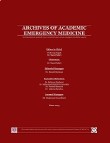Electrocardiographic Findings and In-Hospital Mortalityof COVID-19 Patients; a Retrospective Cohort Study
Although current evidence points to the possible prognostic value of electrocardiographic (ECG)findings for in-hospital mortality of COVID-19 patients, most of these studies have been performed on a smallsample size. In this study, our aim was to investigate the ECG changes as prognostic indicators of in-hospitalmortality.
In a retrospective cohort study, the findings of the first and the second ECGs of COVID-19patients were extracted and changes in the ECGs were examined. Any abnormal finding in the second ECG thatwasn’t present in the initial ECG at the time of admission was defined as an ECG change. ECGs were interpretedby a cardiologist and the prognostic value of abnormal ECG findings for in-hospital mortality of COVID-19 pa-tients was evaluated using multivariate analysis and the report of the relative risk (RR).
Data of the ECGsrecorded at the time of admission were extracted from the files of 893 patients; likewise, the second ECGs couldbe extracted from the records of 328 patients who had an initial ECG. The presence of sinus tachycardia (RR =2.342; p <0.001), supraventricular arrhythmia (RR = 1.688; p = 0.001), ventricular arrhythmia (RR = 1.854; p =0.011), interventricular conduction delays (RR = 1.608; p = 0.009), and abnormal R wave progression (RR = 1.766;p = 0.001) at the time of admission were independent prognostic factors for in-hospital mortality. In the secondECG, sinus tachycardia (RR = 2.222; p <0.001), supraventricular arrhythmia (RR = 1.632; p <0.001), abnormal Rwave progression (RR = 2.151; p = 0.009), and abnormal T wave (RR = 1.590; p = 0.001) were also independentprognostic factors of in-hospital mortality. Moreover, by comparing the first and the second ECGs, it was foundthat the incidence of supraventricular arrhythmia (RR = 1.973; p = 0.005) and ST segment elevation/depression(RR = 2.296; p <0.001) during hospitalization (ECG novel changes) are two independent prognostic factors ofin-hospital mortality in COVID-19 patients.
Due to the fact that using electrocardiographic data iseasy and accessible and it is easy to continuously monitor patients with this tool, ECGs can be useful in identi-fying high-risk COVID-19 patients for mortality.
- حق عضویت دریافتی صرف حمایت از نشریات عضو و نگهداری، تکمیل و توسعه مگیران میشود.
- پرداخت حق اشتراک و دانلود مقالات اجازه بازنشر آن در سایر رسانههای چاپی و دیجیتال را به کاربر نمیدهد.




